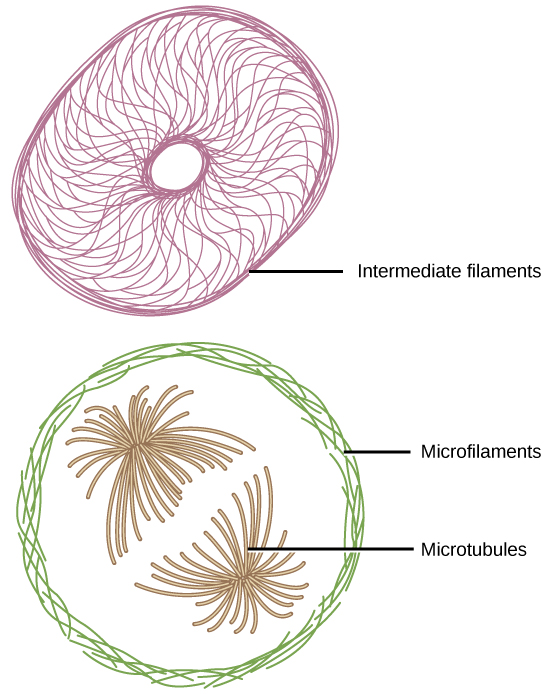3.5 The Cytoskeleton
Learning Objectives
By the end of this section, you will be able to:
- Describe the cytoskeleton
- Compare the roles of microfilaments, intermediate filaments, and microtubules
- Compare and contrast cilia and flagella
Fibres of the Cytoskeleton
If you were to remove all the organelles from a cell, would the plasma membrane and the cytoplasm be the only components left? No. Within the cytoplasm, there would still be ions and organic molecules, plus a network of protein fibres that help maintain the cell’s shape, secure some organelles in specific positions, allow cytoplasm and vesicles to move within the cell, and enable cells within multicellular organisms to move. Collectively, scientists call this network of protein fibres the cytoskeleton. There are three types of fibres within the cytoskeleton: microfilaments, intermediate filaments, and microtubules (Figure 3.17). Here, we will examine each.

Microfilaments are the thinnest of the cytoskeletal fibres and function in moving cellular components, for example, during cell division. They also maintain the structure of microvilli, the extensive folding of the plasma membrane found in cells dedicated to absorption. These components are also common in muscle cells and are responsible for muscle cell contraction. Intermediate filaments are of intermediate diameter and have structural functions, such as maintaining the shape of the cell and anchoring organelles. Keratin, the compound that strengthens hair and nails, forms one type of intermediate filament. Microtubules are the thickest of the cytoskeletal fibres. These are hollow tubes that can dissolve and reform quickly. Microtubules guide organelle movement and are the structures that pull chromosomes to their poles during cell division. They are also the structural components of flagella and cilia. In cilia and flagella, the microtubules are organized as a circle of nine double microtubules on the outside and two microtubules in the center.
Microfilaments

LINK TO LEARNING
Intermediate Filaments

Microtubules

The centrosome is a region near the nucleus of animal cells and contains a pair of centrioles, two structures that lie perpendicular to each other. Each centriole is a cylinder of nine triplets of microtubules. The centrosome replicates itself before a cell divides, and the centrioles play a role in pulling the duplicated chromosomes to opposite ends of the dividing cell. However, the exact function of the centrioles in cell division is not clear, since cells that have the centrioles removed can still divide, and plant cells, which lack centrioles, are capable of cell division.
Flagella and Cilia

Section Summary
The cytoskeleton has three different protein element types. From narrowest to widest, they are the microfilaments (actin filaments), intermediate filaments, and microtubules. Biologists often associate microfilaments with myosin. They provide rigidity and shape to the cell and facilitate cellular movements. Intermediate filaments bear tension and anchor the nucleus and other organelles in place. Microtubules help the cell resist compression, serve as tracks for motor proteins that move vesicles through the cell, and pull replicated chromosomes to opposite ends of a dividing cell. They are also the structural element of centrioles, flagella, and cilia.
Exercises
Glossary
cilium (plural: cilia): a short, hair-like structure that extends from the plasma membrane in large numbers and is used to move an entire cell or move substances along the outer surface of the cell
cytoskeleton: the network of protein fibers that collectively maintains the shape of the cell, secures some organelles in specific positions, allows cytoplasm and vesicles to move within the cell, and enables unicellular organisms to move
flagellum (plural: flagella): the long, hair-like structure that extends from the plasma membrane and is used to move the cell
Media Attribution
- Figure 3.21 modification of work by Dartmouth Electron Microscope Facility, Dartmouth College; scale-bar data from Matt Russell

